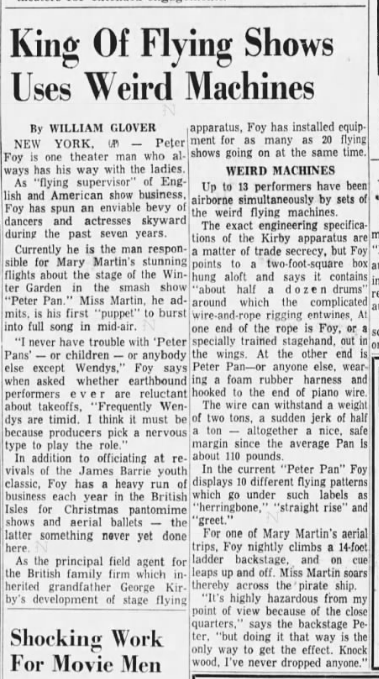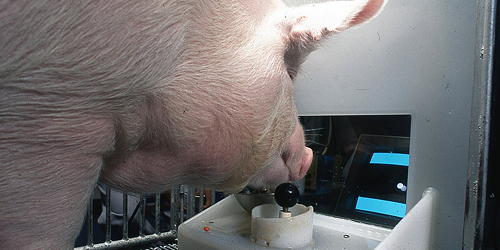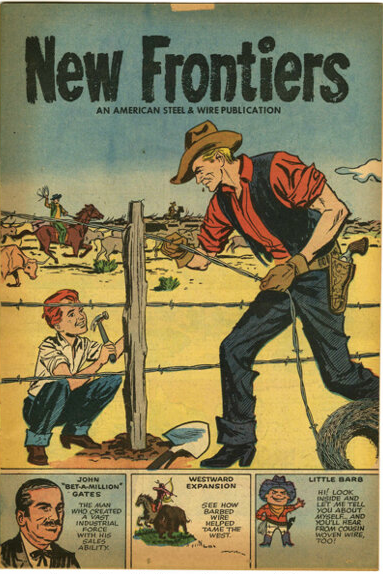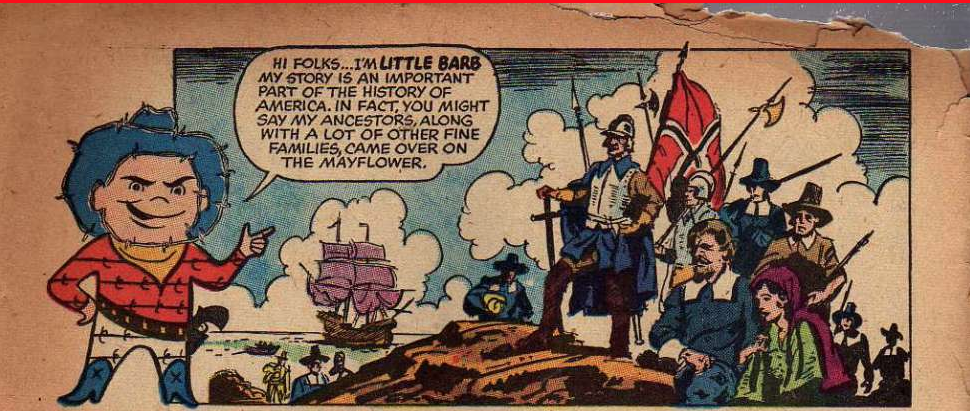February 2021
February 18, 2021
Recipes for Cooking Domestic Rabbit Meat
During World War II, as the country faced meat rationing, the U.S. Government decided to promote rabbit meat as an alternative to beef and chicken. As part of this effort, the Department of the Interior released a pamphlet, "Recipes for Cooking Domestic Rabbit Meat". It included recipes such as "Rabbit Chop Suey," "Vagabond Stew," and "Wartime Rabbit Casserole". The pamphlet noted:
Entrepreneur Martin French of Los Angeles must have had visions of the rabbit-meat market taking off. In 1940, he received trademark protection for "Bunnyburger" — his ground rabbit meat business.

I'd like to think that, in some alternative reality, the government's plan worked and it's possible to go into a McDonald's and order a McBunny with Cheese.
Posted By: Alex - Thu Feb 18, 2021 -
Comments (8)
Category: Food, Cookbooks, 1940s
Kirby’s Flying Ballet
This is the apparatus that famously caused Mary Martin to fly as Peter Pan.
Wikipedia page for Peter Foy.

Posted By: Paul - Thu Feb 18, 2021 -
Comments (4)
Category: Technology, Theater and Stage, Special Effects, 1950s, 1960s
February 17, 2021
Pigs Play Video Games
Researchers at Pennsylvania State University recently succeeded in teaching four pigs how to play a video game. Admittedly, the game was pretty simple. The pigs had to use a joystick to move a cursor toward a target wall on the computer screen. If they hit the wall, they'd hear a "bloop" and then get a food reward.The pigs performed at a level far above random chance. However, the researchers noted that their skill level was below that of non-human primates. The scientists speculated that this may have been because it was difficult for the pigs to manipulate the joystick with their snout. Or perhaps it was because all four pigs were far-sighted and "despite attempts to position the computer monitor appropriately, it is impossible to know how well the pigs were able to see, and subsequently correctly discriminate between targets."
More info: Lab Manager, Frontiers in Psychology

Thanks to Gerald Sacks!
Posted By: Alex - Wed Feb 17, 2021 -
Comments (1)
Category: Animals, Experiments, Videogames and Gamers
Follies of the Madmen #500
I suppose I should have come up with something super-special for the 500th installment of this series, but this will have to suffice!
Sure, kill the talking lion and then...style his mane?
Posted By: Paul - Wed Feb 17, 2021 -
Comments (1)
Category: Animals, Business, Advertising, Death, Comics, 1950s, Hair and Hairstyling
February 16, 2021
Sounds of the Unborn
Musician Luca Yupanqui is releasing her first album, Sounds of the Unborn, in April.Though she had some help from her parents. Luca was still in her mother's womb when her parents recorded her in utero using electrodes and then used "biosonic MIDI technology" to transform the sounds into something like music.
It's being promoted as the "world’s first LP made from sounds inside the womb".
More info: The Guardian
Posted By: Alex - Tue Feb 16, 2021 -
Comments (1)
Category: Babies, Music
Clair de Lune Espagno
A trip to the moon teaches a lovesick suitor a lesson.
Creator's Wikipedia page.
Posted By: Paul - Tue Feb 16, 2021 -
Comments (2)
Category: Aliens, Costumes and Masks, Dreams and Nightmares, Movies, Special Effects, Spaceflight, Astronautics, and Astronomy, Foreign Customs, 1900s, Love & Romance
February 15, 2021
Morse Code for Drivers
In 1960, the Automobile Legal Association proposed that all drivers should learn a code that would allow them to communicate with each other on the road via honks.One short honk would mean, 'Left blinker going'. Three short honks would mean, 'A light burned out'. One long honk would mean, 'Get over in the right lane.' And so on.

The Terre Haute Star - Sep 17, 1960
Although the honking code never caught on, the idea of allowing drivers to communicate with each other has persisted. The 21st-century spin on it are the various phone apps (such as bump.com, Driver Talk, or PL8chat) that allow you to send messages to other cars by entering their license plate number. Of course, both drivers have to be signed up with the app for this to work. Which means these apps have, for now, very limited practical use.
Posted By: Alex - Mon Feb 15, 2021 -
Comments (3)
Category: Languages, Cars
New Frontiers (of Barb Wire)
Thrill to the history of barb wire with "Little Barb!" (Or "American Barb" if you prefer.)


Posted By: Paul - Mon Feb 15, 2021 -
Comments (1)
Category: Agriculture, Anthropomorphism, History, Regionalism, Advertising
February 14, 2021
The Human Relationship Simulator
This post seemed appropriate for Valentine's Day, since it's about an engineer's attempt to use machine logic to improve the "ambiguities of the woman/man relationship".James F. Hollander was a patent attorney with a degree in electrical engineering. In the late 1970s he invented and patented what he called the "Human Relationship Simulator". It consisted of a box with various dials.
Even after reading his patent, and an article about his invention, I'm not exactly sure how the thing operated. From what I can gather, if a couple were having an argument, or needed to make a decision (such as where to go for dinner), they could both adjust dials on the Simulator, and it would give them an answer. And measure the intensity of their feelings.

Here's more info from a 1977 article in the Asbury Park Press:
Each subject uses dials that represent four areas — compliance with society, attention to own desire, social pressure and personal inclination. The personal inclination and social pressure gauges are intricately detailed to show adamant 'yes' or 'no' responses, or degrees such as strong preference, or very much or some.
Attention to desire is measured in readings of low, medium and high, as is compliance with society.
As the subjects feed this information into the panels, other gauges measure tension, feelings, guilt or pride, emotional independence, like and dislike, and influence, based on each decision.
The machine does the thinking, lights a decision of 'yes' or 'no' and tells the subjects their emotional responses....
In a marriage situation, Hollander said the device could show the individuals why something is going wrong in the relationship if arguments are portrayed and feelings defined.
"I wanted to pick out the ambiguities of the woman/man relationship," he pointed out.

Asbury Park Press - Aug 29, 1977
If that doesn't seem entirely clear, then here's a sample from Hollander's patent:
Posted By: Alex - Sun Feb 14, 2021 -
Comments (0)
Category: Technology, Patents, Psychology, Marriage, 1970s, Love & Romance
Lagoa das Sete Cidades
Two lakes, separated by a narrow strip of land, yet each ecologically and chromatically distinct.The Wikipedia entry.


Posted By: Paul - Sun Feb 14, 2021 -
Comments (1)
Category: Lakes, Ponds, Rivers, Streams, Swamps and Other Bodies of Fresh Water, Europe, Natural Wonders
| Get WU Posts by Email | |
|---|---|

| Who We Are |
|---|
| Alex Boese Alex is the creator and curator of the Museum of Hoaxes. He's also the author of various weird, non-fiction books such as Elephants on Acid. Paul Di Filippo Paul has been paid to put weird ideas into fictional form for over thirty years, in his career as a noted science fiction writer. He has recently begun blogging on many curious topics with three fellow writers at The Inferior 4+1. Chuck Shepherd Chuck is the purveyor of News of the Weird, the syndicated column which for decades has set the gold-standard for reporting on oddities and the bizarre. Our banner was drawn by the legendary underground cartoonist Rick Altergott. Contact Us |

